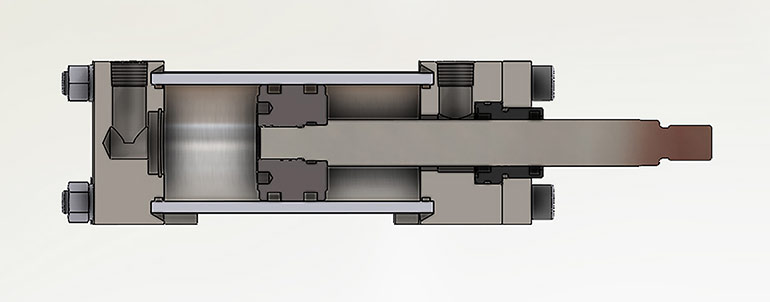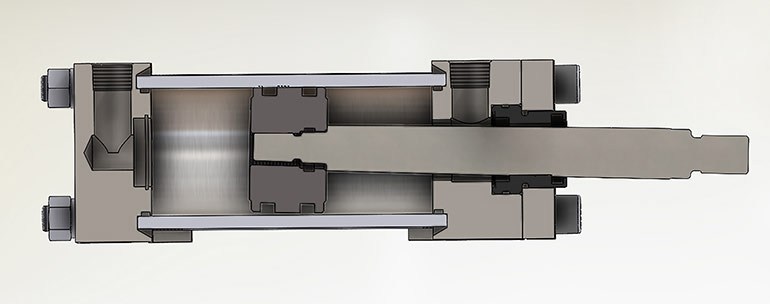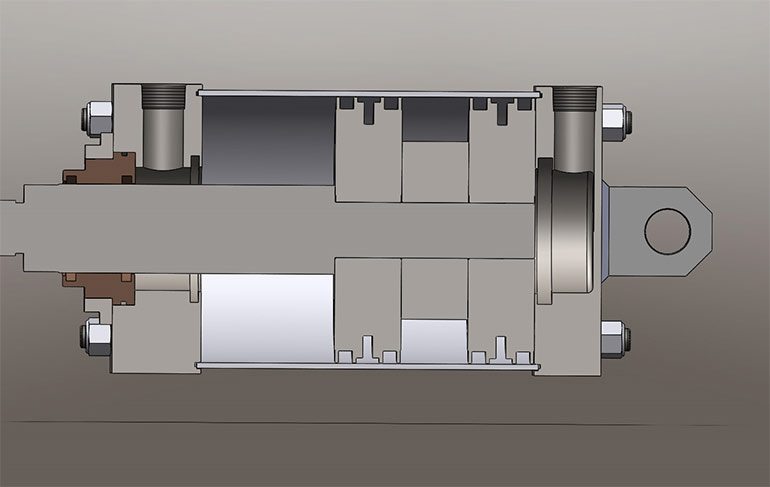Contributed by James Czegledi, Engineering Manager
Quality-built hydraulic and pneumatic cylinders are designed to last for long life, and when installed and maintained properly, cylinders are expected to meet or exceed projected lifecycles. However, misalignment and/or side load on the rod bearing and/or the piston can cause premature damage leading to cylinder failure.

Example of normal piston rod alignment
Cylinder side loading occurs when a piston rod is forced from its designed travel route. Misalignment or bending force can occur at any point of the cylinder orientation and can cause at minimum, cylinder wear usually 180 degrees opposite of the actual side load, consequently causing seal failure through contaminants generated from scored piston rods, rod bearing, piston and/or tube.
The manufacturer of the cylinder has a responsibility to maintain specific tolerance specifications especially concentricity to center as any deviation from the designed specification and tolerance will induce an unwanted side load to the cylinder.
Proper machine alignment is critical when installing a cylinder. For example, in an assembly-type system, where a cylinder and load are disconnected the cylinder is pushing a load in various directions for the next process. If the cylinder does not hit the load square, it could create a deflection of the piston rod, which could create side load.
Applications as described above would benefit from the use of a stop tube. Stop tubes would provide additional bearing support and minimize deflection of the piston rod. Stop tubes are usually used for longer strokes (of more than 36 or 40 in.) to increase the distance between the piston and the rod cartridge or commonly referred as L over D. Increased bearing surface and support reduces the amount of deflection in the piston rod. The best stop tube design incorporates a two piston stop tube design.

Example of side loading on a cylinder piston rod
Proper mounting selection like a spherical bearing mount or spherical bearing rod eye can compensate for some side loading. Trunnion mounted cylinders move with the side load to reduce their impact.
Excessive wear
Excessive wear on the bearing surface will create friction, heat and possibly scoring or galling of the materials and potential surface degradation. You can tell when this has occurred because you will have uneven wear on the rod. A common indicator of this are shiny spots or polishing on one side of the rod but not the other. Frequent visual inspections of the piston rod are encouraged to spot such wear early.
Environmental impacts
Understanding what type of environment where the cylinder will be installed is also crucial to preventing side loading. The surroundings are important when it comes to contamination ingress into the cylinder. Contamination will always evolve into a catastrophic failure.

Hydraulic cylinder design using a stop tube for piston rod support
Cylinder manufacturers work closely with customers to obtain all the information necessary about the application and environment. This allows us to design against these potential contaminants and other possible causes of failure.
Using an application data sheet, customers will supply information such as:
- stroke length
- how much weight the cylinder needs to push or pull in terms of weight
- whether it is a guided or unguided load
- what type of fluid is being used
- will the cylinder be exposed to extreme temperatures
- mounting style
The knowledge of the cylinder orientation — whether mounted horizontally or vertically — is one of the most important data points for understanding side load possibilities. Side loading is more likely to happen in the horizontal orientation, because of the forces of gravity against the piston rod. A vertical orientation has a more natural resistance.
Conclusion
Side loading is one of the most common causes of hydraulic cylinder failure. The uneven wear, fluid leaks, seal failure and possibly bent rods caused by side loading can all be prevented from the start and proper installation, alignment and mounting. Finally, preventative care should be taken, including visual inspection of the piston rod regularly to examine it for scoring and galling.
Peninsular Cylinder Co.
peninsularcylinders.com
Filed Under: Cylinders & Actuators, Fluid Power Basics